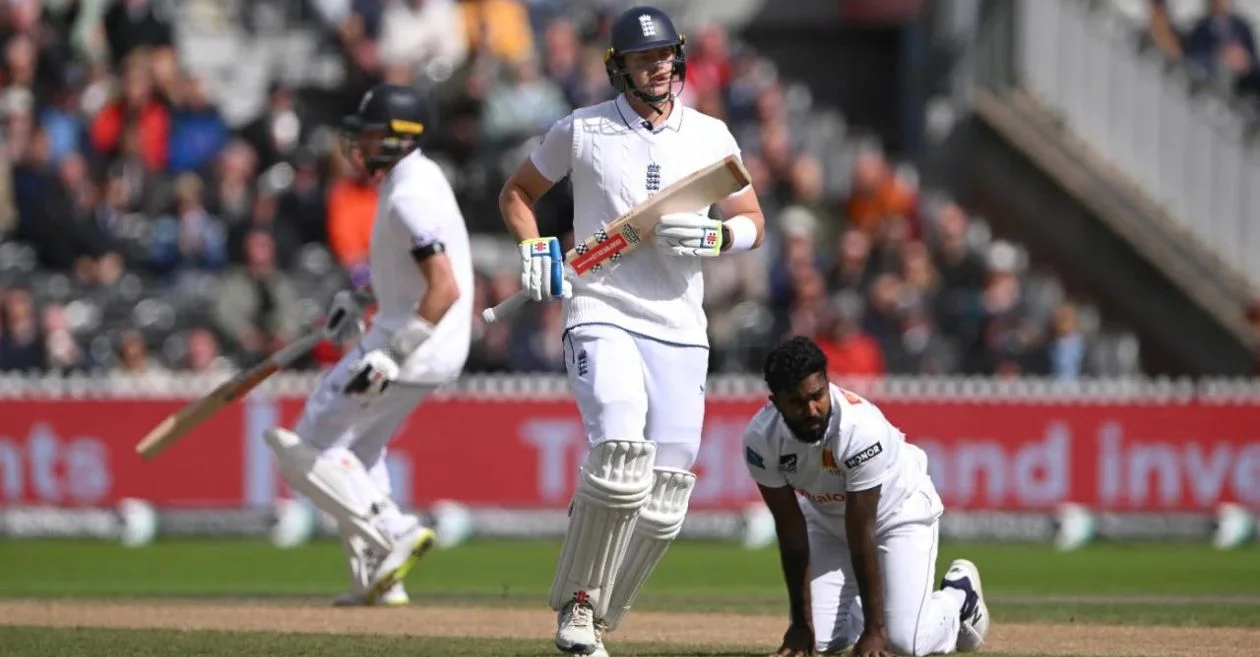Day 3 of the first Test match between England and Sri Lanka at Manchester saw a full day of action, with England establishing their dominance despite Sri Lanka managing to eke out a modest lead. The day was marked by the standout performance of England’s rising talent, Jamie Smith, whose sensational century propelled England into a commanding position. By stumps, Sri Lanka was battling at 204/6, holding a slender lead of 82 runs, as the match poised itself for a thrilling finish.
Jamie Smith’s record-breaking feat, England’s lower-order resilience, and Sri Lanka’s second innings struggles defined the day. As the Test heads into the final days, both teams will need to summon their best efforts to tip the balance in their favor.
Jamie Smith’s Record-Breaking Century
The highlight of Day 3 was undoubtedly Jamie Smith’s remarkable century, which not only put England in a strong position but also etched his name into the record books. At just 22 years old, Smith became the youngest wicketkeeper-batter from England to score a century in Test cricket, breaking a 94-year-old record held by Les Ames. His composed and calculated knock of 119 runs was a display of maturity beyond his years, showcasing his ability to handle pressure on the biggest stage.
Smith’s innings began with England at a precarious 67/3, but he quickly steadied the ship. He partnered with Gus Atkinson for a crucial 66-run stand for the seventh wicket, which proved to be a turning point in England’s innings. His technique against both spin and pace was exemplary, as he maneuvered the field with precision and found the gaps effortlessly. Smith’s ton was met with a standing ovation from the Manchester crowd, a testament to his growing stature in the England setup.
Smith’s century was not just an individual milestone; it was the backbone of England’s innings, driving them to a formidable total of 358. His ability to adapt and counter Sri Lanka’s varied bowling attack was the key to England’s revival, as they turned the tide in their favor.
England’s Lower-Order Resilience
England’s lower-middle order proved to be the difference-maker on Day 3, as they showcased immense grit and resilience to rescue the team from a precarious position. After the early loss of wickets left England wobbling, the lower-order batsmen stepped up to the challenge, demonstrating the depth and determination that has become a hallmark of this England team.
Gus Atkinson, in particular, played a crucial supporting role alongside Jamie Smith. The duo’s 66-run partnership for the seventh wicket not only stabilized the innings but also shifted the momentum firmly in England’s favor. Atkinson’s ability to absorb pressure and rotate the strike effectively allowed Smith to play his natural game, and together they frustrated the Sri Lankan bowlers.
Even as Prabath Jayasuriya and Asitha Fernando posed constant threats with the ball, England’s lower order refused to buckle under pressure. The resilience shown by the likes of Atkinson and Matthew Potts highlighted England’s fighting spirit, as they ensured that the team posted a competitive total. This effort from the tailenders was instrumental in frustrating the Sri Lankan bowlers, who had earlier looked set to run through England’s batting lineup.
Sri Lanka’s Second Innings Struggles
Sri Lanka’s response in their second innings got off to a disastrous start, with their top order crumbling under pressure. Trailing by 122 runs, the visitors needed a solid start, but England’s bowlers had other ideas. Nishan Madushka and Kusal Mendis were both dismissed for ducks, leaving Sri Lanka reeling at 95/4. The early breakthroughs by England put Sri Lanka on the back foot, and they struggled to build momentum throughout the day.
The Sri Lankan top order failed to cope with England’s disciplined bowling attack, and their dismissals left the middle order with a massive task ahead. It was only through the efforts of Angelo Mathews that Sri Lanka managed to stay afloat. Mathews, the veteran campaigner, stepped up when his team needed him most, forming crucial partnerships with the middle-order batsmen to prevent a complete collapse.
However, Sri Lanka’s inability to counter England’s pace and spin effectively meant that they were always playing catch-up. The lack of substantial contributions from their top order placed enormous pressure on Mathews and Kamindu Mendis, who did their best to keep the innings alive.
Angelo Mathews Leads the Fightback
As Sri Lanka found themselves in deep trouble, Angelo Mathews once again proved why he is regarded as one of the team’s most dependable players. Mathews played a fighting knock, combining resilience with calculated aggression to help Sri Lanka recover from their early setbacks. His experience and composure were on full display as he anchored the innings and provided much-needed stability.
Mathews formed a crucial 78-run partnership with Kamindu Mendis for the fifth wicket, which kept Sri Lanka in the match. This stand was vital in helping Sri Lanka chip away at the deficit and rebuild their innings after the early losses. Mathews’ ability to rotate the strike and keep the scoreboard ticking was crucial in frustrating the English bowlers, who were eager to make further inroads.
However, Mathews’ dismissal by Chris Woakes proved to be a turning point. Woakes, who had been bowling with great control, delivered a crucial blow by removing Mathews just when Sri Lanka seemed to be gaining some momentum. Mathews’ departure for a well-fought 65 left Sri Lanka vulnerable once again, as the lower order now had to take up the responsibility of extending the lead.
Injuries and Setbacks: Sri Lanka’s Uphill Battle
Sri Lanka’s fightback was further hampered by injuries and setbacks that added to their woes. Wicketkeeper-batter Dinesh Chandimal, who had been a key figure in their first innings, suffered a blow to his thumb while keeping earlier in the day. The injury forced him to retire hurt, leaving Sri Lanka without one of their most experienced players during a crucial phase of the match.
Chandimal’s absence was a significant blow to Sri Lanka’s chances, as he had been in good form throughout the series. His ability to steady the ship and play long innings was sorely missed as the team tried to navigate their way through a challenging second innings. Chandimal later returned to the crease with a heavily strapped thumb, displaying immense courage, but his injury clearly impacted his ability to bat at full strength.
Adding to Sri Lanka’s troubles were England’s fielding lapses, which allowed them to extend their slender lead. Mathews was dropped on 65, and Kamindu Mendis on 39, both off the bowling of Matthew Potts. These missed opportunities could have given England the upper hand, but Sri Lanka capitalized on the chances to keep the match alive.
England’s Bowling Dominance
England’s bowlers played a pivotal role in keeping Sri Lanka under pressure throughout the day. The pace duo of Chris Woakes and Ollie Pope, along with the spin of Joe Root, made life difficult for the Sri Lankan batters. Pope’s decision to replace the ball in the 42nd over after it lost its shape brought immediate assistance to the bowlers, leading to key breakthroughs.
Chris Woakes was particularly effective with his swing and seam movement, claiming the crucial wicket of Angelo Mathews. Woakes’ disciplined bowling kept Sri Lanka’s run rate in check and made it difficult for the batsmen to settle. His ability to extract movement off the pitch and keep the batsmen guessing was a key factor in England’s bowling success.
Joe Root, despite being more renowned for his batting, chipped in with a vital wicket, dismissing Kamindu Mendis just as he was starting to look dangerous. Root’s part-time spin added variety to England’s attack, and his knack for breaking partnerships provided England with timely breakthroughs.
Sri Lanka’s Slim Lead and Final Day Expectations
By the end of Day 3, Sri Lanka found themselves at 204/6, holding a slender lead of 82 runs. While the lead is modest, it gives Sri Lanka something to defend as they head into the final days of the Test. With Dinesh Chandimal still at the crease and Kamindu Mendis unbeaten on 56, Sri Lanka will be hoping for their lower order to add valuable runs and stretch the lead as much as possible.
England, on the other hand, will be confident of wrapping up the remaining wickets quickly and chasing down whatever target is set before them. With their bowlers in fine form and their batting lineup in good touch, England will feel they have the upper hand as the Test enters its decisive phase.
The final days of the Test promise to be a gripping contest, with both teams vying for supremacy. Sri Lanka will need a strong rearguard effort to put England under pressure, while England will be aiming to maintain their dominance and secure a victory in the first Test of the series.
Please check for information on the best betting sites in India – https://selectory.org/best-betting-sites/















